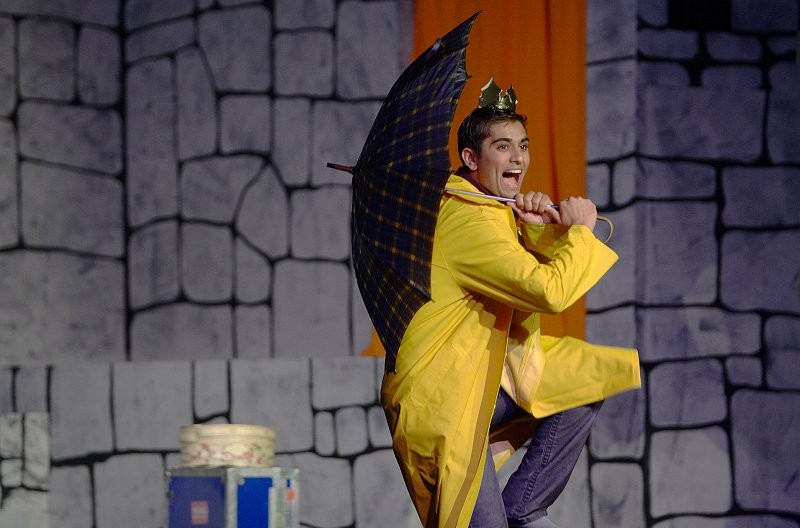There are a lot of outstanding reasons to incorporate puppetry into your high school drama class curriculum. Puppets are fun, hone performance skills in beginning students and advanced alike, and can be relatively cheap to construct. But before launching a puppet project of any sort, you may have concerns that students may find it “stupid” or if you are in an environment where you have to justify what you do according to the concept of “rigor” you may wonder how to do that.
RIGOR
In California, where I teach, our performing arts standards encompass:
- 1.0 ARTISTIC PERCEPTION
- 2.0 CREATIVE EXPRESSION
- 3.0- CONTEXT- HISTORICAL AND CULTURAL
- 4.0 AESTHETIC VALUING
- 5.0 CONNECTIONS, RELATIONSHIPS AND APPLICATIONS
A well-designed performance project allows students to meet each of these standards. In the case of this one:
- Working in pairs, students use CREATIVE EXPRESSION to construct animal or object puppets out of paper bags, using whatever good old craft supplies you happen to have around the department (I recommend googly eyes and pipe cleaners especially, along with construction paper and markers.
- Students use CREATIVE EXPRESSION to write a script in which the animal and object meet, have a problem with each other, and have a change of feelings.
- Students coach another pair of students practicing AESTHETIC VALUING AND ARTISTIC PERCEPTION, giving them opportunities to practice for a small audience before their final performance in front of the class.
- This activity can be extended to work with CONTEXT-HISTORICAL AND CULTURAL, by studying such offshoots as shadow puppets, the vaudeville circuit, and the Muppets. Depending on the scope of teacher and student interest, students can research and learn about puppet, model, and all kinds of creature construction for theatre and film.
PROJECT SEQUENCE
- Students are paired. If you have a group of three, there should be two animals and one object or one animal and two objects.
- Hand out paper bags.
- Hand each partnership two index cards, with a puppet name written on each one. The purpose of this is multifold. If given a choice between two names, students make simple choices, instead of naming their puppet something too long or using pop culture to name their puppet. This also mostly avoids the student impulse to create some sort of character based on a harmful stereotype. Please never give a name of a current student to be used in these exercises. Avoid names of current known cartoon characters (eg Dexter) . Kids usually like the nostalgic ones and don’t recognize them. Here is a list of names I have used with success:
- Bingo
- Fifi
- Tex
- Lester
- Minerva
- Crandall
- Lulu
- Launce
- Dorcas
- Choo Choo
- Huey
- Cosmo
- Coco
- Louden
- Queenie
- Daisy
- Spike
- Bosco
- Slim
- Sparkle
- Gramps
- Lucky
- Mojo
- Rocky
- Student should decide in pairs who gets which name, and who is the animal and who is the object.
- Students construct the puppets. This will take them the better part of a class period.
- While this is happening, create a puppet stage- as simple as a table with a black cloth or sheet over it or crazy elaborate if you’d like. Feel free to dim the lights and have students hold flashlights on it, or use a spot if you have the tech to do so in your theatre or blackbox
- Students write a short script, based on Daniel Judah Sklar’s playwriting approach, where characters
- Meet up
- Have a problem with each other
- Have a change of feelings.
SCAFFOLDING TO PERFORMANCE
- FOOTLOOSE: Open the next class before puppet work starts in earnest by allowing students to work with someone other than their partner to tell a story using only their feet. I allow them about five minutes to work this out. Then we hold up the puppet theatre sheet and everybody watches short stories told with feet. We discuss this afterwards, how pace, attitude and proximity can be used to tell a story nonverbally. It helps with puppet movement.
- PUPPET INTRODUCTIONS: Students in pairs introduce their characters IN CHARACTER on the puppet stage. These can take the form of the puppets casually relating like the actors in a promotional spot for a new show. They can mention age, their name, how they feel about each other. These can be as structured or as loose as you would like. This is an opportunity for you to give feedback to them (great voice, awesome master gesture, speak up, think about how your puppet moves) and for students to also see others make strong choices and get practice before the performance.
- WATCH ITS: Small ‘dress rehearsals” in groups of four where a pair performs for another pair and then flips. A great opportunity for students to assess their readiness for performance. I make a small exit ticket that asks students to share a strength an area for improvement, and then assess whether the piece is ready
PERFORMANCE TIPS
Consider rearranging the seating in your room to allow students to be close to the puppet theatre and lower than it. Focus attention on the puppets as much as possible.
You will be amazed at what this brings out in certain students. Enjoy that.
Allow yourself to watch these and laugh. Allow students to relax and give each other good feedback. Students become very interested in these, and in a high pressure school, they have fun creating characters and telling a story, which is what kids should do sometimes.
If you want to do these for small children or something, that could be lovely. Regardless, enjoy an activity where students of different abilities and backgrounds let loose and get back to the basics of storytelling and character.


